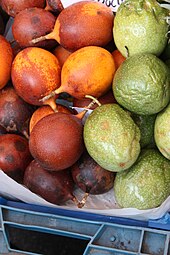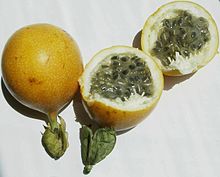Sweet Granadilla
| Sweet Granadilla | ||||||||||||
|---|---|---|---|---|---|---|---|---|---|---|---|---|

Sweet Granadilla ( Passiflora ligularis ) |
||||||||||||
| Systematics | ||||||||||||
|
||||||||||||
| Scientific name | ||||||||||||
| Passiflora ligularis | ||||||||||||
| Yuss. |
The sweet granadilla ( Passiflora ligularis ) is a species of the passion flower ( Passiflora ) in the passion flower family (Passifloraceae). It grows as a liana and has flowers about 10 centimeters in size. The natural range is in South America, Central America and Mexico, but it is cultivated in subtropical areas in Africa, Asia, Australia and on the Pacific islands. The fruits are used as fruit.
description
The sweet granadilla is an evergreen , overgrown liana with woody bottom and bare, weakly furrowed shoots. The spiral tendrils grow from the leaf and flower stalk axils. The leaves are arranged alternately. The stipules are pointed ovoid and up to 2.5 inches long. The leaf stalk is up to 2 centimeters long and carries three pairs of glands that sit on horizontally protruding, about 1 centimeter long stems. The leaf blade is ovate, 8 to 20 centimeters long, 6 to 15 centimeters wide, with entire margins with a heart-shaped base and an extended tip. Both sides are bare.
The approximately 10 cm diameter flowers are often in pairs on up to 4 cm long stems. In the bud they are surrounded by three broadly ovate, pointed, weakly toothed and 2.5 to 4 centimeters long bracts . The sepals are ovate, pale green and have a thorny tip. The petals are lanceolate and white with purple points. The tips of the secondary crowns are thread-like, white with purple horizontal stripes and slightly curved at the end. The five stamens are mostly fused and have light yellow anthers. The pistil and the stylus are greenish white.
The fruits are broad, egg-shaped berries, tapering at the base, 7 to 8 centimeters in size . Unripe fruits are blue-green and often covered with numerous small greenish-white dots that are missing along five narrow longitudinal strips. Ripe fruits have a thin, hard, brittle and shiny orange-yellow skin with greenish or brownish spots. The white or yellowish mesocarp is dry, spongy, tough and tasteless. It has long, cylindrical growths on which the seeds grow. The seed coat is glassy, yellowish white or crystal clear. The pulp is thick and has a sweet, barely sour taste. The seeds are flat, ovate, about 7 millimeters long and 4 millimeters wide, glossy black with whitish edges and a slightly wrinkled surface.
distribution
The natural range of the species is in North America in the Mexican states Chiapas , Colima , Michoacán , Oaxaca , Puebla and Veracruz , in Central America in Costa Rica, El Salvador, Guatemala, Honduras and Panama and in South America in Venezuela, Bolivia, Colombia, Ecuador and Peru. It is grown scattered in subtropical areas of Africa, Asia, Australia and on the Pacific islands.
Systematics
The sweet granadilla ( Passiflora ligularis ) is a species from the genus of passion flowers ( Passiflora ), subgenus Passiflora in the passion flower family (Passifloraceae). There the genus is assigned to the tribe Passifloreae in the subfamily Passifloroideae. The species was first scientifically described in 1805 by Antoine-Laurent de Jussieu . The specific epithet ligularis comes from Latin and means "tongue-shaped".
use

The Sweet Granadilla is following the passion fruit ( Passiflora edulis ) is economically important type of passion flower. While the passion fruit is mainly used to make juice, the sweet granadilla fruits are eaten fresh with the seeds as dessert fruit. The fruit peel is broken open and the contents slurped or spooned out. The fruits are rarely used to make juices or as an ingredient in desserts.
The species thrives in tropical mountains and in subtropical climates and is frugal in terms of soil quality. It can withstand light frost, but not intense heat. Propagation takes place using seeds or cuttings. The fruits are harvested ripe and can only be kept for a short time if left untreated.
swell
literature
- Bernd Nowak, Bettina Schulz: Pocket dictionary of tropical crops and their fruits . Quelle & Meyer, Wiebelsheim 2009, ISBN 978-3-494-01455-5 , p. 427-429 .
- Helmut Genaust: Etymological dictionary of botanical plant names. 3rd, completely revised and expanded edition. Nikol, Hamburg 2005, ISBN 3-937872-16-7 , p. 340 (reprint from 1996).
Individual evidence
- ^ German name according to Nowak, Schulz: Pocket dictionary of tropical useful plants and their fruits , p. 427
- ↑ a b Nowak, Schulz: Pocket dictionary of tropical useful plants and their fruits , p. 427
- ↑ Nowak, Schulz: Pocket dictionary of tropical useful plants and their fruits , pp. 427–428
- ↑ a b c d Nowak, Schulz: Pocket dictionary of tropical useful plants and their fruits , p. 428
- ↑ a b c Passiflora ligularis . In: Germplasm Resources Information Network (GRIN). United States Department of Agriculture, accessed November 16, 2012 .
- ↑ Exactly: Etymological Dictionary of Botanical Plant Names , p. 340
- ↑ Nowak, Schulz: Pocket dictionary of tropical useful plants and their fruits , p. 429
Web links
- Passiflora ligularis. In: The Plant List. Retrieved November 16, 2012 .


